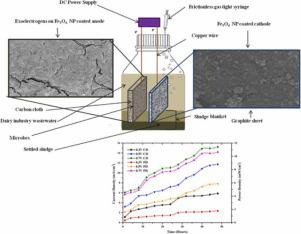Journal of Environmental Chemical Engineering ( IF 7.4 ) Pub Date : 2021-09-10 , DOI: 10.1016/j.jece.2021.106326 Gini Rani 1 , Kadirvelu Krishna 2 , K.N. Yogalakshmi 1

|
The present study assesses the performance of microbial electrolysis cell (MEC) to generate electric current using (I) uncoated/untreated electrodes and (II) Fe3O4 nanoparticles (FNPs) coated electrodes. The cyclic voltammetry (CV) reports highest conductivity of 58 Sm−1 in (II) while lowest (0.18 Sm−1) in (I) electrodes. The impedance spectroscopy confirms bulk resistivity of 375 kΩ in (I) electrodes while relatively lowest resistivity of 0.4 kΩ in (II) electrodes. Two sets of single chamber membraneless MECs is operated simultaneously at different applied voltage (300 mV, 500 mV and 700 mV): RI (uncoated electrodes) and RII, (FNP coated electrodes). The RII attains maximum current density and power density of 15.2 mAcm−1 and 10.6 mWcm−2 respectively at 0.7 V while RI achieves the maximum current density and power density of 4.03 mAcm−2 and 2.8 mWcm−2 respectively at same voltage. Moreover, the current density recorded in electrodes (II) is significantly higher compared to electrodes (I) measured using CV. The result suggests FNP to be an excellent catalyst which improves biosynthesis of electric current. The biologically active environment consisting of anaerobic electrogenic microbes supported biosynthesis/generation of high electric current along with other metabolites produced from the microbes mediated redox reaction.
中文翻译:

提高微生物电解槽中Fe3O4纳米颗粒层状碳电极的电化学性能
本研究使用 (I) 未涂层/未处理电极和 (II) Fe 3 O 4纳米粒子 (FNP) 涂层电极评估微生物电解池 (MEC) 产生电流的性能。循环伏安法 (CV) 报告(II) 中的最高电导率为 58 Sm -1,而(I) 电极中的电导率最低 (0.18 Sm -1 )。阻抗谱证实 (I) 电极的体电阻率为 375 kΩ,而 (II) 电极的电阻率相对最低,为 0.4 kΩ。两组单室无膜 MEC 在不同的施加电压(300 mV、500 mV 和 700 mV)下同时运行:RI(未涂层电极)和 RII(FNP 涂层电极)。RII 达到 15.2 mAcm 的最大电流密度和功率密度-1和10.6 mWcm -2分别为0.7V,而RI达到4.03 MACM的最大电流密度和功率密度-2和2.8 mWcm -2分别在相同的电压。此外,与使用 CV 测量的电极 (I) 相比,电极 (II) 中记录的电流密度明显更高。结果表明 FNP 是一种极好的催化剂,可改善电流的生物合成。由厌氧生电微生物组成的生物活性环境支持高电流的生物合成/产生以及由微生物介导的氧化还原反应产生的其他代谢物。











































 京公网安备 11010802027423号
京公网安备 11010802027423号